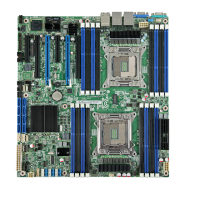Intel® Server Board S2600CO Family TPS Platform Management Functional Overview
Revision 1.4 61
Intel order number G42278-004
6.9.2 Memory Thermal Throttling
The server board provides support for system thermal management through open loop throttling
(OLTT) and closed loop throttling (CLTT) of system memory. Normal system operation uses
closed-loop thermal throttling (CLTT) and DIMM temperature monitoring as major factors in
overall thermal and acoustics management. In the event that BIOS is unable to configure the
system for CLTT, it defaults to open-loop thermal throttling (OLTT). In the OLTT mode, it is
assumed that the DIMM temperature sensors are not available for fan speed control.
Throttling levels are changed dynamically to cap throttling based on memory and system
thermal conditions as determined by the system and DIMM power and thermal parameters. The
BMC’s fan speed control functionality is linked to the memory throttling mechanism used.
The following terminology is used for the various memory throttling options:
Static Open Loop Thermal Throttling (Static-OLTT): OLTT control registers are
configured by BIOS MRC remain fixed after post. The system does not change any of
the throttling control registers in the embedded memory controller during runtime.
Static Closed Loop Thermal Throttling (Static-CLTT): CLTT control registers are
configured by BIOS MRC during POST. The memory throttling is run as a closed-loop
system with the DIMM temperature sensors as the control input. Otherwise, the system
does not change any of the throttling control registers in the embedded memory
controller during runtime.
Dynamic Open Loop Thermal Throttling (Dynamic-OLTT): OLTT control registers are
configured by BIOS MRC during POST. Adjustments are made to the throttling during
runtime based on changes in system cooling (fan speed).
Dynamic Closed Loop Thermal Throttling (Dynamic-CLTT): CLTT control registers
are configured by BIOS MRC during POST. The memory throttling is run as a closed-
loop system with the DIMM temperature sensors as the control input. Adjustments are
made to the throttling during runtime based on changes in system cooling (fan speed).
Both Static and Dynamic CLTT modes implement a Hybrid Closed Loop Thermal Throttling
mechanism whereby the Integrated Memory Controller estimates the DRAM temperature in
between actual reads of the memory thermal sensors.
6.10 Messaging Interfaces
The BMC supports the following communications interfaces:
Host SMS interface by means of low pin count (LPC)/keyboard controller style (KCS)
interface
Host SMM interface by means of low pin count (LPC)/keyboard controller style (KCS)
interface
Intelligent Platform Management Bus (IPMB) I
2
C interface
LAN interface using the IPMI-over-LAN protocols
Every messaging interface is assigned an IPMI channel ID by IPMI 2.0.

